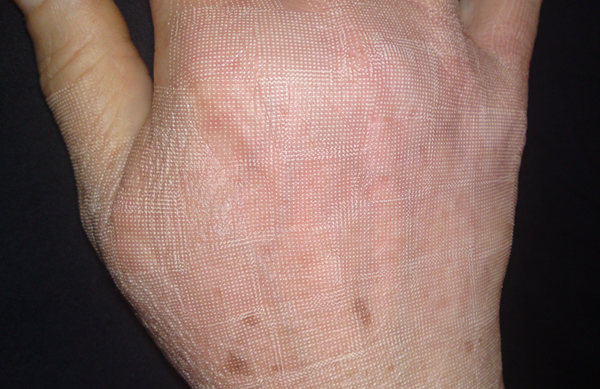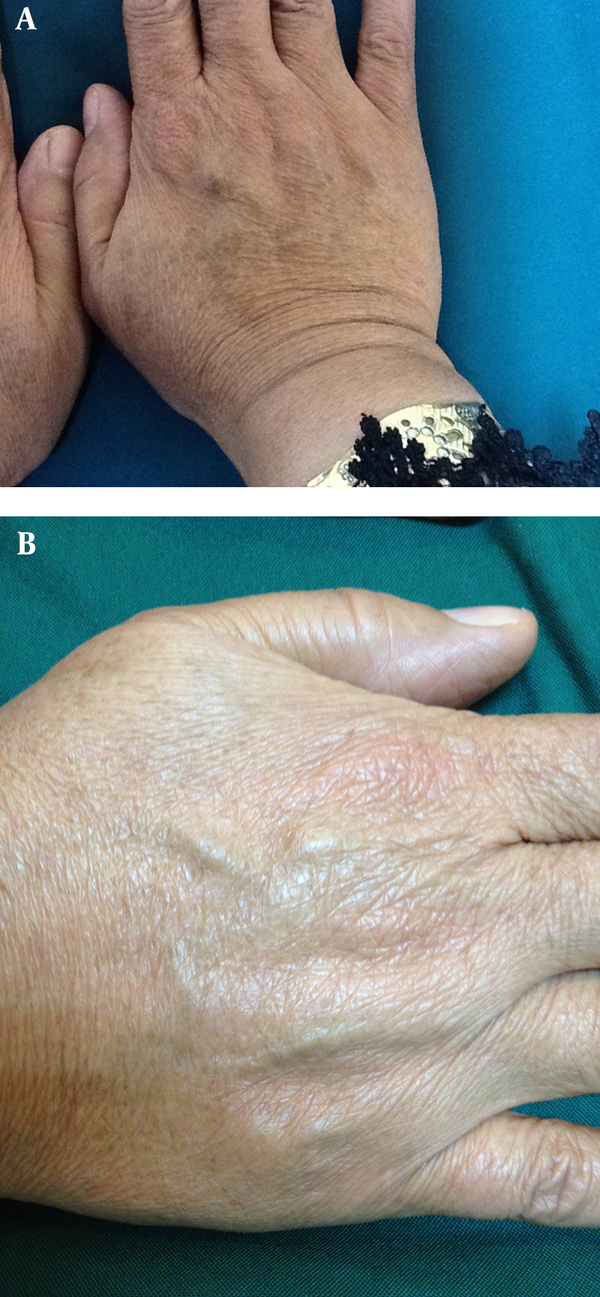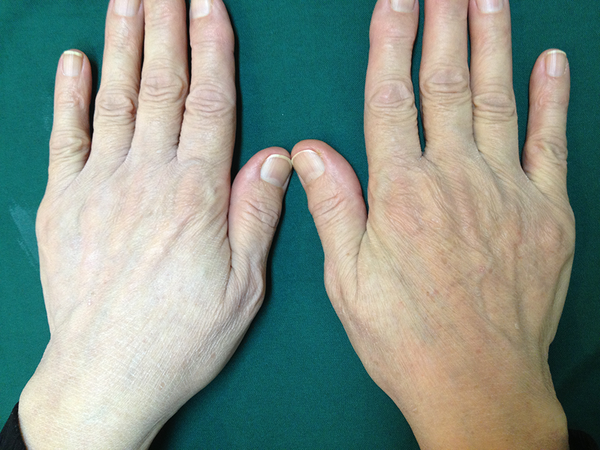Abstract
Background:
Ablative fractional CO2 laser (AFCL) has been reported to be safe and effective to use for preventing hand photoaging in a recent pilot study.Objectives:
This study aimed to evaluate the efficacy of AFCL in improvement of hand photoaging in 25 patients.Patients and Methods:
A prospective, before- after, single blind study was conducted in 25 patients who presented for desired treatment of hand photoaging. Patients received three treatments sessions with AFCL.Results:
All enrolled patients were female and received three treatment sessions. There was no incidence of significant adverse effects such as scarring, prolonged erythema sever edema, post inflammatory pigmentary changes, or infection. Mean improvement one month after three treatments was 48.3% (95% CI, 42.6 - 53.9) for skin wrinkling, 53.3% (95% CI, 47.9 - 58.8) for skin pigmentation, 46.9% (95% CI, 41.4 - 52.2) for skin texture, and 54.9% (95% CI, 49.3 - 60.5) for overall cosmetic outcome (all P < 0.05).Conclusions:
AFCL can be used safely and effectively in the treatment of hand photoaging.Keywords
1. Background
The dorsum of the Hands is one of the mostly visible body parts that undergoes aging (1). Appearance of the hands can reveal a person’s age (2). Hands are also important for interpersonal interactions and contact (3). Therefore, requests for hand rejuvenation have increased (4-6). A number of approaches to hand rejuvenation have been used including topical agents, chemical peels, fat augmentation, sclerotherapy and phlebectomy, light based and laser approaches such as intense pulsed light, erbium: YAG laser, 1320 nm Nd: YAG laser, and non-ablative fractional laser (1, 7-10). Other methods such as the lipofilling restore the fat volume loss, improve the texture and color of the skin, and act as a natural structure. After a short, time a rejuvenation treatment is recommended for better and continuous results; however, this invasive procedure needs anesthesia. Recently, ablative fractional CO2 laser (AFCL) was used in a pilot study of 10 patients for photoaging of the hands with desirable results (11).
2. Objectives
We enrolled patients with moderate to severe photo aged hands to assess the efficacy and safety of using AFCL resurfacing for hand rejuvenation with the goal of optimizing improvements in skin texture, wrinkling, and pigmentation.
3. Patients and Methods
The study protocol conformed to the guidelines of the 1975 Declaration of Helsinki and was approved by Tehran University Institutional Review Board and Ethics Committee, Tehran, Iran. Informed consent was obtained from all participants before enrollment.
We included 25 patients in this single-center prospective study. All enrolled patients were Iranian (Fitzpatrick skin type II-IV), who were referred to our hospital for desired treatment of signs of hand photoaging (wrinkling, pigmentations, and changes in skin texture) between August 2012 and December 2012. Exclusion criteria included active infection in site of treatment, pregnancy, a history of collagen vascular disease, a history of keloid or abnormal scar formation, known allergy to topical anesthetics, any cosmetic procedure or systemic isotretinoin use within the preceding year.
The treatment area was cleansed with soap and water. A lidocaine/prilocaine (eutectic mixture of equal quantities) topical anesthetic was applied 20 minutes before treatment. Contact cooling with icepack was administered before and during treatment. Treatment was administered to the dorsum of the hand between the wrist and metacarpophalangeal joints (MCP) using UNIXEL CO2 laser unit (South Korea, Seoul, Gyeonggi-do-Union Medical). The used AFCL setting was as follows: 25 W; pitch, 800 µm (676 DOTS in each 400 mm2); pulse duration, 500 μsec; and 2 points of shot without overlap (Figure 1). After the procedure, zinc oxide ointment was applied. The participants were instructed to cover the treatment area with zinc oxide ointment four times a day for five days. Sunscreen of at least 30 SPF was advised to use after five days.
Patients received three treatment sessions at four-week intervals. One hand was randomly treated first and the other hand was treated after the patients were followed one month after completion of the first hand therapy.
One month after the final session, blinded physicians assessed the photographs to evaluate the degree of improvement in three clinical indicators: wrinkling, pigmentation, and skin texture. Evaluating physicians were not aware of which photograph was before and after treatment.
The degree of improvement in clinical indicators between pretreatment and one month post treatment was assessed by a quartile scale in which “one” indicated no signs of improvement and “four” indicated significant improvement. In addition, the degree of improvement was calculated as percentage.
3.1. Statistical Analysis
For each patient, the pretreatment and post treatment scores were recorded. Pretreatment scores were recorded as baseline on the date of the first treatment. Post treatment scores were recorded on the date of final follow-up one month after completion of treatment.
Percentage change in score was calculated as the score difference divided by the baseline score. For each clinical indicator (wrinkling, pigmentation and skin texture) and for overall cosmetic outcome, absolute score change, raw percentage change, mean percentage change, and 95% CI were calculated. The paired-samples t-test was used to test changes in each clinical indicator score from baseline to one month after treatment. P value < 0.05 was considered statistically significant.
Right Hand of a Patient Immediately After Treatment With Ablative Fractional CO2 Laser

4. Results
All 25 patients desiring for treatment of photoaging of their hands completed three treatment sessions with AFCL. All were female with the mean age of 51.4 years (range, 39 - 65 years). The patients had Fitzpatrick skin type of II to IV: 12%, type II; 72%, type III; and 16%, type IV.
Post treatment side effects included mild to moderate erythema (lasting 5 - 7 days), severe erythema (lasting 1 - 2 days), and minor crusting (lasting 1-3 days).
During treatment, patients reported minimal pain. There was no incidence of adverse effects such as scarring, prolonged erythema (lasting more than 7 days), significant edema, post inflammatory hyperpigmentation or hypopigmentation, or infection.
From before treatment to one month after the third treatment, the mean score decreased from 2.9 to 1.5 (mean improvement, 48.3%; 95% CI, 42.6 - 53.9) for skin wrinkling, from 3.1 to 1.4 (mean improvement, 53.3%; 95% CI, 47.9 - 58.8) for skin pigmentation, from 3 to 1.6 (mean improvement, 46.9%; 95% CI, 41.4 - 52.2) for skin texture, and from 3.12 to 1.4 (mean improvement, 54.9%; 95% CI, 49.3 - 60.5) for overall cosmetic outcome (P < 0.05 for all) (Table 2).
All patients after completion of three treatments on the study hand returned for treatment of the other hand. Clinical pictures of patients demonstrating improvement in photoaging of the treated hands are seen in Figure 2 A, 2 B, and 3.
Laser Therapy by Ablative Fractional CO2 Laser in the Right Hand in a Forty-Nine-Year-Old Female

Comparing Hands after Three Laser Therapy Sessions of the Left Hand in a Fifty-Eight-Year-Old Female

Demographic Characteristics of Participants
Summary of Improvement With Ablative CO2 Laser of Photoaging Hands
5. Discussion
For the first time, Hantash et al. described AFCL resurfacing in 2007 (12). Since then, AFCL has been used for resurfacing of the face with significant results and acceptable safety profile (13-17), but caution has been considered for non-facial areas such as neck, chest and hands due to the possibility of delayed wound healing and abnormal scarring (18, 19). Therefore, the efficacy and safety of AFCL in hand resurfacing has been studied less frequently until 2011, when Stebbins and Hanke (11) reported AFCL resurfacing as a highly tolerable, safe, and efficient modality in hand resurfacing. In their pilot study, ten patients were treated on the hands with a single pass of DOT AFCL at settings of 20 W, 500-mm pitch, and 500 to 700-μsec pulse duration with no overlap and investigators rated mean improvement at 26% to 50% for wrinkles, 51% to 75% for pigment, and 26% to 50% for texture, one month after the final treatment. In addition, participants rated mean improvement after final treatment at 26% to 50% for wrinkles, 51% to 75% for pigment, and 51% to 75% for texture. In that pilot study, ablative fractional resurfacing was safe and effective for the treatment of all markers of aging of the hands; significant edema noted after the first treatment only in one participant (11).
Finally, our study indicated that AFCL could be a safe and effective new therapeutic approach in management of hand photoaging.
Significant improvement in the clinical appearance of photo aged hands (i.e. wrinkling, pigmentation and skin texture) can be achieved without significant adverse effects such as scarring, prolonged erythema, severe edema, post inflammatory pigmentation changes, and infection. Our study had some limitation such as small number of enrolled patients, short follow-up period, and subjective improvement assessment. Therefore, further studies are needed to find the best treatment protocol as well as the optimal frequency and interval of treatment sessions. On the other hand, we recommended investigating the efficacy of this therapeutic modality in future studies by using histopathologic examination or noninvasive techniques such as ultrasonography, which can provide more accurate information.
References
-
1.
Jakubietz RG, Jakubietz MG, Kloss D, Gruenert JG. Defining the basic aesthetics of the hand. Aesthetic Plast Surg. 2005;29(6):546-51. [PubMed ID: 16328643]. https://doi.org/10.1007/s00266-005-0100-6.
-
2.
Park TH, Yeo KK, Seo SW, Kim JK, Lee JH, Park JH, et al. Clinical experience with complications of hand rejuvenation. J Plast Reconstr Aesthet Surg. 2012;65(12):1627-31. [PubMed ID: 22763320]. https://doi.org/10.1016/j.bjps.2012.06.008.
-
3.
Goldman A, Prati C, Rossato F. Hand rejuvenation using intense pulsed light. J Cutan Med Surg. 2008;12(3):107-13. [PubMed ID: 18544292].
-
4.
Abrams HL, Lauber JS. Hand rejuvenation. The state of the art. Dermatol Clin. 1990;8(3):553-61. [PubMed ID: 2379338].
-
5.
Wendt JR. Distal, dorsal superior extremity plasty. Plast Reconstr Surg. 2000;106(1):210-3. [PubMed ID: 10883637].
-
6.
Jakubietz RG, Kloss DF, Gruenert JG, Jakubietz MG. The ageing hand. A study to evaluate the chronological ageing process of the hand. J Plast Reconstr Aesthet Surg. 2008;61(6):681-6. [PubMed ID: 18262858]. https://doi.org/10.1016/j.bjps.2007.12.028.
-
7.
Inglefield C. Nonsurgical hand rejuvenation with Dermicol-P35 30G. Aesthet Surg J. 2009;29(3 Suppl):S19-21. [PubMed ID: 19577177]. https://doi.org/10.1016/j.asj.2009.03.008.
-
8.
Butterwick KJ. Rejuvenation of the aging hand. Dermatol Clin. 2005;23(3):515-27. vii. [PubMed ID: 16039431]. https://doi.org/10.1016/j.det.2005.04.007.
-
9.
Sadick NS, Smoller B. A study examining the safety and efficacy of a fractional laser in the treatment of photodamage on the hands. J Cosmet Laser Ther. 2009;11(1):29-33. [PubMed ID: 19177257]. https://doi.org/10.1080/14764170802612992.
-
10.
Jih MH, Goldberg LH, Kimyai-Asadi A. Fractional photothermolysis for photoaging of hands. Dermatol Surg. 2008;34(1):73-8. [PubMed ID: 18053047]. https://doi.org/10.1111/j.1524-4725.2007.34011.x.
-
11.
Stebbins WG, Hanke CW. Ablative fractional CO2 resurfacing for photoaging of the hands: pilot study of 10 patients. Dermatol Ther. 2011;24(1):62-70. [PubMed ID: 21276159]. https://doi.org/10.1111/j.1529-8019.2010.01379.x.
-
12.
Hantash BM, Bedi VP, Chan KF, Zachary CB. Ex vivo histological characterization of a novel ablative fractional resurfacing device. Lasers Surg Med. 2007;39(2):87-95. [PubMed ID: 17115384]. https://doi.org/10.1002/lsm.20405.
-
13.
Weiss R, Weiss M, Beasley K. Prospective split face trial of affixed spacing array computed scanned fractional CO2 laser versus hand scanned 1,550 nm fractional for rhytids.In: Kissimee FL, editor. American society for Laser Medicine and Surgery Conference. 2008.
-
14.
Lomeo A, Bolner A, Scattolo N, Guzzo P, Amadori F, Sartori S, et al. HPLC analysis of HbA1c in dried blood spot samples (DBS): a reliable future for diabetes monitoring. Clin Lab. 2008;54(5-6):161-7. [PubMed ID: 18780661].
-
15.
Berlin AL, Hussain M, Phelps R, Goldberg DJ. A prospective study of fractional scanned nonsequential carbon dioxide laser resurfacing: a clinical and histopathologic evaluation. Dermatol Surg. 2009;35(2):222-8. [PubMed ID: 19215259]. https://doi.org/10.1111/j.1524-4725.2008.34413.x.
-
16.
Ortiz AE, Tremaine AM, Zachary CB. Long-term efficacy of a fractional resurfacing device. Lasers Surg Med. 2010;42(2):168-70. [PubMed ID: 20166157]. https://doi.org/10.1002/lsm.20885.
-
17.
Tierney EP, Hanke CW. Fractionated carbon dioxide laser treatment of photoaging: prospective study in 45 patients and review of the literature. Dermatol Surg. 2011;37(9):1279-90. [PubMed ID: 22988990]. https://doi.org/10.1111/j.1524-4725.2011.02082.x.
-
18.
Fife DJ, Fitzpatrick RE, Zachary CB. Complications of fractional CO2 laser resurfacing: four cases. Lasers Surg Med. 2009;41(3):179-84. [PubMed ID: 19291745]. https://doi.org/10.1002/lsm.20753.
-
19.
Avram MM, Tope WD, Yu T, Szachowicz E, Nelson JS. Hypertrophic scarring of the neck following ablative fractional carbon dioxide laser resurfacing. Lasers Surg Med. 2009;41(3):185-8. [PubMed ID: 19291746]. https://doi.org/10.1002/lsm.20755.